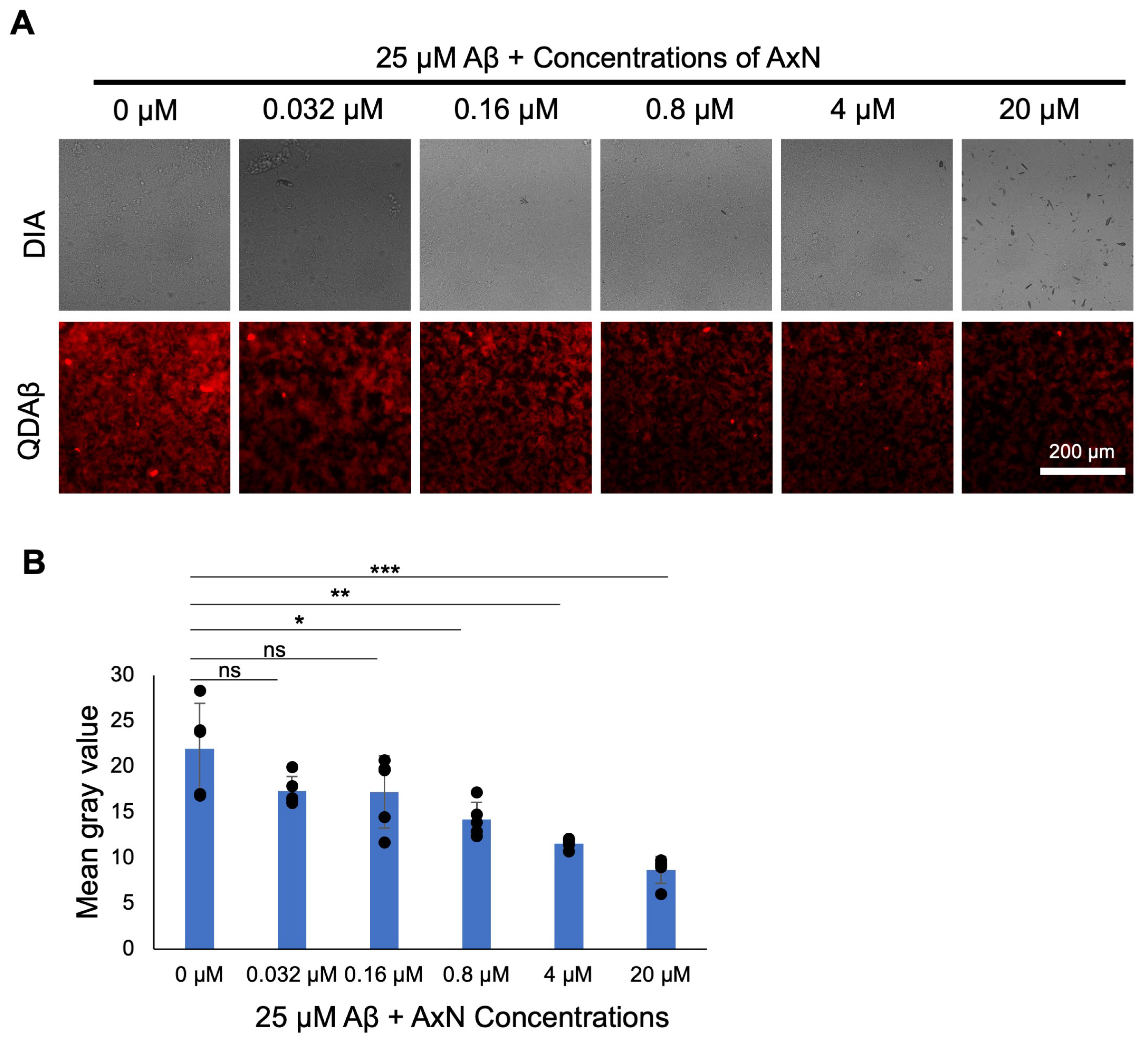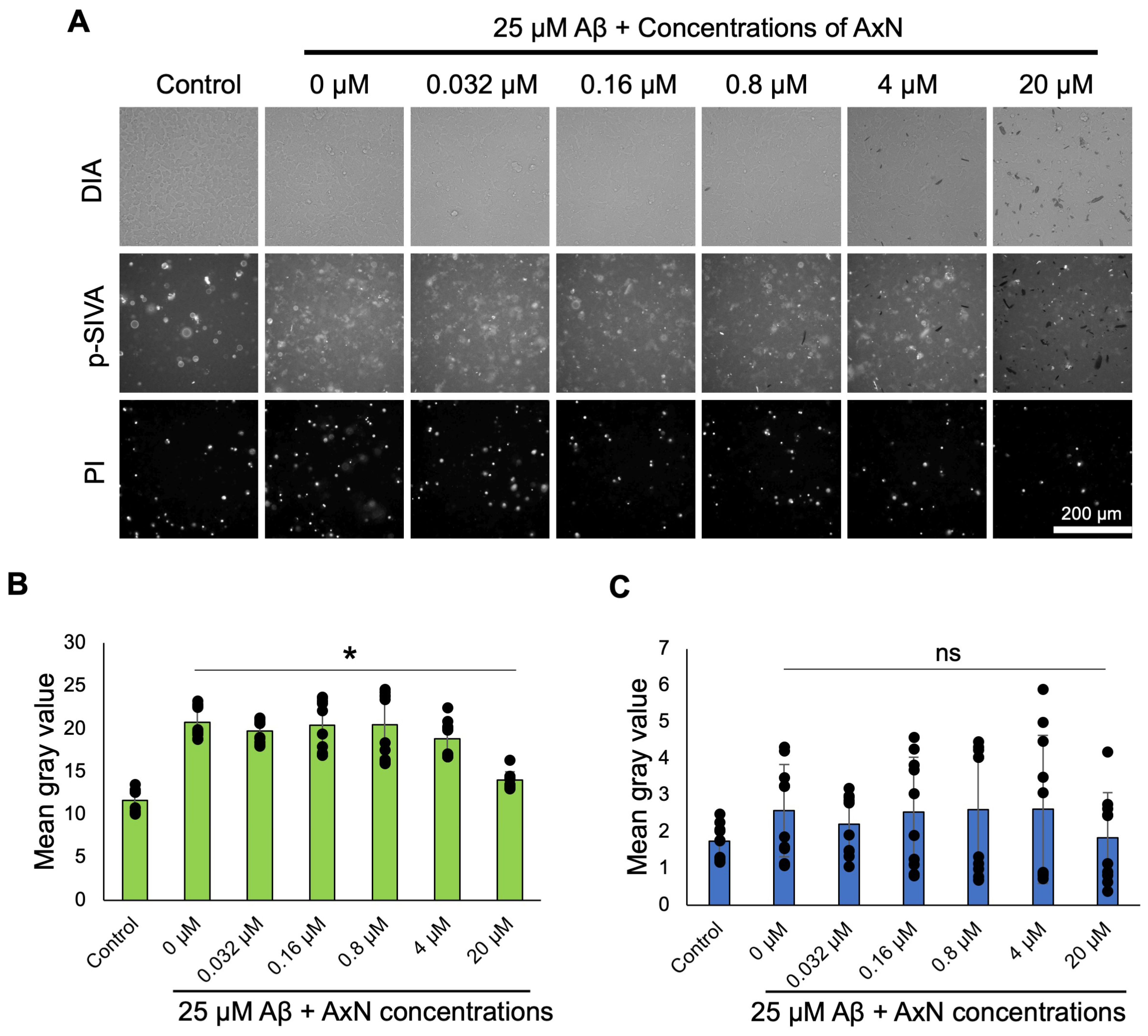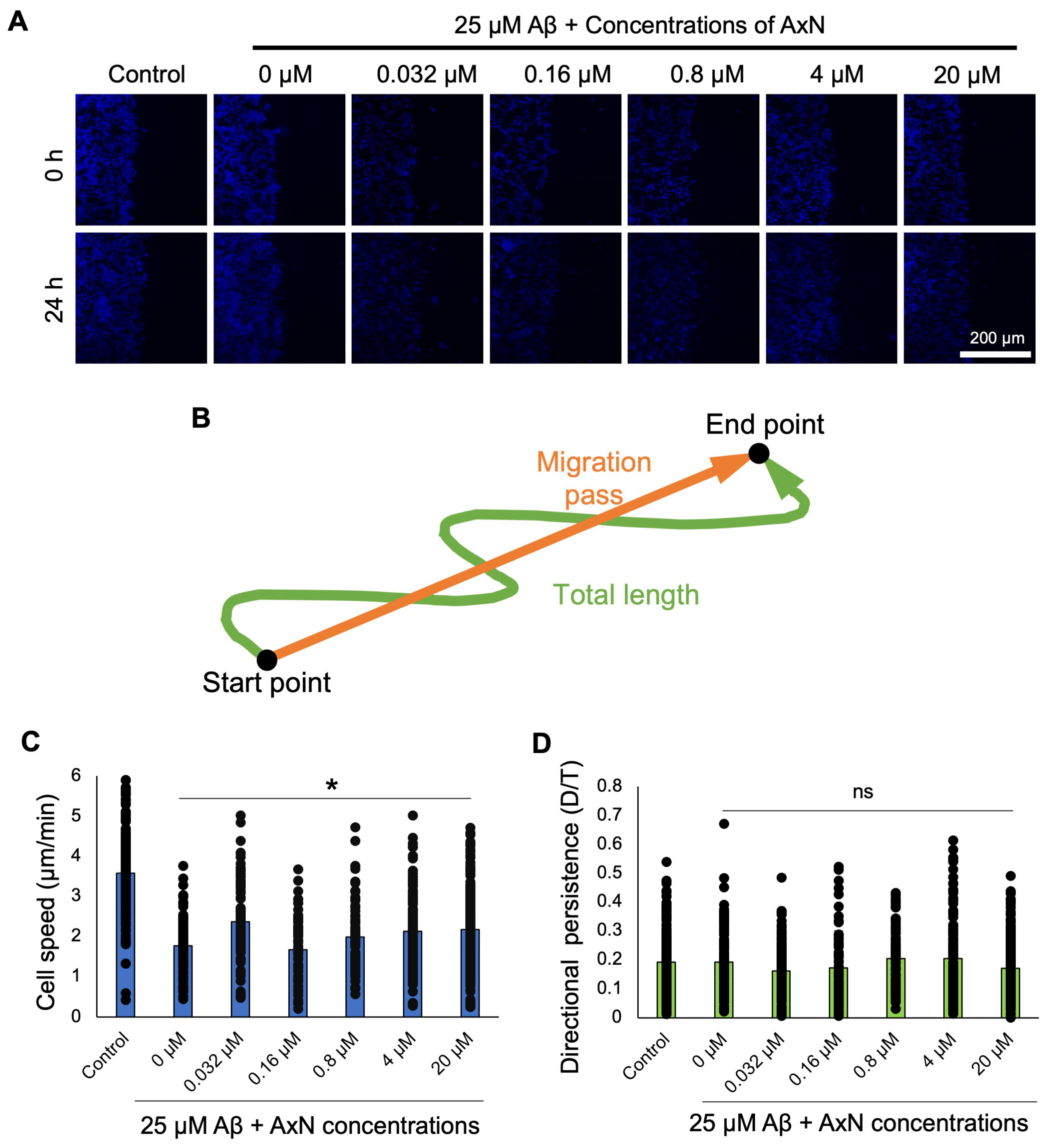Elucidation of the Neuroprotective Effects of Astaxanthin Against Amyloid β Toxicity in the SH-SY5Y Human Neuroblastoma Cell Line
Abstract
1. Introduction
2. Results
2.1. Inhibitory Effect of Aβ Aggregation by AxN
2.2. Attenuation of Aβ Aggregation and Deposition by AxN on SH-SY5Y Neuroblastoma Cells
2.3. Inhibitory Effects of AxN on Aβ Deposition in SH-SY5Y Neuroblastoma Cells
2.4. Effects of AxN on Aβ-Induced Apoptosis in SH-SY5Y Neuroblastoma Cells
2.5. Effects of AxN on SH-SY5Y Neuroblastoma Cell Motility
3. Discussion
4. Materials and Methods
4.1. Materials
4.2. Cell Culture
4.3. Preparation of Aβ42
4.4. MSHTS System
4.5. Visualization of Aβ Aggregation in the Cell Line
4.6. ThT Assay
4.7. Apoptosis Assay
4.8. WHA
4.9. Migratory Assay
4.10. Statistical Analysis
5. Conclusions
Supplementary Materials
Author Contributions
Funding
Data Availability Statement
Conflicts of Interest
Abbreviations
| Aβ | Amyloid β |
| AxN | Astaxanthin |
| DMEM | Dulbecco’s Modified Eagle Medium |
| DMSO | Dimethyl sulfoxide |
| FN | Fibronectin |
| MSHTS | Microliter-scale high-throughput screening system |
| PBS | Phosphate-buffered saline |
| PI | Propidium iodide |
| p-SIVA | Polarity-sensitive indicator of viability and apoptosis |
| QD | Quantum dot |
| ThT | Thioflavin T |
| WHA | Wound healing assay |
References
- Hardy, J.; Selkoe, D.J. The amyloid hypothesis of Alzheimer’s disease: Progress and problems on the road to therapeutics. Science 2002, 297, 353–356. [Google Scholar] [CrossRef]
- Scheltens, P.; Blennow, K.; Breteler, M.M.; de Strooper, B.; Frisoni, G.B.; Salloway, S.; Van der Flier, W.M. Alzheimer’s disease. Lancet 2016, 388, 505–517. [Google Scholar] [CrossRef]
- Tang, M.; Pi, J.; Long, Y.; Huang, N.; Cheng, Y.; Zheng, H. Quantum dots-based sandwich immunoassay for sensitive detection of Alzheimer’s disease-related Aβ1-42. Spectrochim. Acta. Part A Mol. Biomol. Spectrosc. 2018, 201, 82–87. [Google Scholar] [CrossRef]
- Lane, C.A.; Hardy, J.; Schott, J.M. Alzheimer’s disease. Eur. J. Neurol. 2018, 25, 59–70. [Google Scholar] [CrossRef] [PubMed]
- Song, Z.; He, C.; Yu, W.; Yang, M.; Li, Z.; Li, P.; Zhu, X.; Xiao, C.; Cheng, S. Baicalin attenuated Aβ1-42-induced apoptosis in SH-SY5Y cells by inhibiting the Ras-ERK signaling pathway. BioMed Res. Int. 2022, 2022, 9491755. [Google Scholar] [CrossRef] [PubMed]
- Dehghani, M.; Jalal, R.; Rashidi, M.R. Kinetic and thermodynamic insights into the interaction of Aβ1-42 with astaxanthin and aggregation behavior of Aβ1-42: Surface plasmon resonance, microscopic, and molecular docking studies. Biophys. Chem. 2021, 275, 106612. [Google Scholar] [CrossRef] [PubMed]
- Oliyaei, N.; Moosavi-Nasab, M.; Tanideh, N.; Iraji, A. Multiple roles of fucoxanthin and astaxanthin against Alzheimer’s disease: Their pharmacological potential and therapeutic insights. Brain Res. Bull. 2023, 193, 11–21. [Google Scholar] [CrossRef]
- Lee, N.; Youn, K.; Yoon, J.H.; Lee, B.; Kim, D.H.; Jun, M. The role of fucoxanthin as a potent Nrf2 activator via Akt/GSK-3β/Fyn axis against amyloid-β peptide-induced oxidative damage. Antioxidants 2023, 12, 629. [Google Scholar] [CrossRef]
- El-Agnaf, O.M.; Mahil, D.S.; Patel, B.P.; Austen, B.M. Oligomerization and toxicity of beta-amyloid-42 implicated in Alzheimer’s disease. Biochem. Biophys. Res. Commun. 2000, 273, 1003–1007. [Google Scholar] [CrossRef]
- Lin, Y.; Im, H.; Diem, L.T.; Ham, S. Characterizing the structural and thermodynamic properties of Aβ42 and Aβ40. Biochem. Biophys. Res. Commun. 2019, 510, 442–448. [Google Scholar] [CrossRef]
- Maeda, T.; Shimamori, K.; Kurita, H.; Tokuraku, K.; Kuragano, M. Amyloid β interferes with wound healing of brain microvascular endothelial cells by disorganizing the actin cytoskeleton. Exp. Cell Res. 2024, 436, 113958. [Google Scholar] [CrossRef]
- Selkoe, D.J. Alzheimer’s disease: Genes, proteins, and therapy. Physiol. Rev. 2001, 81, 741–766. [Google Scholar] [CrossRef]
- Tokuraku, K.; Marquardt, M.; Ikezu, T. Real-time imaging and quantification of amyloid-β peptide aggregates by novel quantum-dot nanoprobes. PLoS ONE 2009, 4, e8492. [Google Scholar] [CrossRef]
- Liu, X.; Shibata, T.; Hisaka, S.; Osawa, T. Astaxanthin inhibits reactive oxygen species-mediated cellular toxicity in dopaminergic SH-SY5Y cells via mitochondria-targeted protective mechanism. Brain Res. 2009, 1254, 18–27. [Google Scholar] [CrossRef] [PubMed]
- Guerin, M.; Huntley, M.E.; Olaizola, M. Haematococcus astaxanthin: Applications for human health and nutrition. Trends Biotechnol. 2003, 21, 210–216. [Google Scholar] [CrossRef] [PubMed]
- Pritam, P.; Deka, R.; Bhardwaj, A.; Srivastava, R.; Kumar, D.; Jha, A.K.; Jha, N.K.; Villa, C.; Jha, S.K. Antioxidants in Alzheimer’s disease: Current therapeutic significance and future prospects. Biology 2022, 11, 212. [Google Scholar] [CrossRef]
- Su, W.; Xu, W.; Liu, E.; Su, W.; Polyakov, N.E. Improving the treatment effect of carotenoids on Alzheimer’s disease through various nano-delivery systems. Int. J. Mol. Sci. 2023, 24, 7652. [Google Scholar] [CrossRef]
- Copat, C.; Favara, C.; Tomasello, M.F.; Sica, C.; Grasso, A.; Dominguez, H.G.; Conti, G.O.; Ferrante, M. Astaxanthin in cancer therapy and prevention (Review). Biomed. Rep. 2025, 22, 66. [Google Scholar] [CrossRef]
- Liu, N.; Lyu, X.; Zhang, X.; Zhang, F.; Chen, Y.; Li, G. Astaxanthin attenuates cognitive deficits in Alzheimer’s disease models by reducing oxidative stress via the SIRT1/PGC-1α signaling pathway. Cell Biosci. 2023, 13, 173. [Google Scholar] [CrossRef]
- Mayor, J.; Cuesta, A.; Espinosa-Ruíz, C.; Esteban, M.Á. In vitro effects of astaxanthin on bacterial and cell viability, cell migration and mitochondrial activities in four fish cell lines. Aquac. Rep. 2023, 31, 101636. [Google Scholar] [CrossRef]
- Mularczyk, M.; Michalak, I.; Marycz, K. Astaxanthin and other Nutrients from Haematococcus pluvialis-Multifunctional Applications. Mar. Drugs 2020, 18, 459. [Google Scholar] [CrossRef] [PubMed]
- Park, J.S.; Chyun, J.H.; Kim, Y.K.; Line, L.L.; Chew, B.P. Astaxanthin decreased oxidative stress and inflammation and enhanced immune response in humans. Nutr. Metab. 2010, 7, 18. [Google Scholar] [CrossRef] [PubMed]
- Lobos, P.; Bruna, B.; Cordova, A.; Barattini, P.; Galáz, J.L.; Adasme, T.; Hidalgo, C.; Muñoz, P.; Paula-Lima, A. Astaxanthin protects primary hippocampal neurons against noxious effects of Aβ-oligomers. Neural Plast. 2016, 2016, 3456783. [Google Scholar] [CrossRef] [PubMed]
- Huanood, G.; Swamy, M.M.M.; Sasaki, R.; Shimamori, K.; Kuragano, M.; Enkhbat, E.; Suga, Y.; Anetai, M.; Monde, K.; Tokuraku, K. Screening of a fraction with higher amyloid β aggregation inhibitory activity from a library containing 210 mushroom extracts using a microliter-scale high-throughput screening system with quantum dot imaging. Foods 2024, 13, 3740. [Google Scholar] [CrossRef]
- Sasaki, R.; Tainaka, R.; Ando, Y.; Hashi, Y.; Deepak, H.V.; Suga, Y.; Murai, Y.; Anetai, M.; Monde, K.; Ohta, K.; et al. An automated microliter-scale high-throughput screening system (MSHTS) for real-time monitoring of protein aggregation using quantum-dot nanoprobes. Sci. Rep. 2019, 9, 2587. [Google Scholar] [CrossRef]
- Shimamori, K.; Nambu, T.; Kawamata, D.; Kuragano, M.; Nishishita, N.; Iimori, T.; Yamanaka, S.; Uwai, K.; Tokuraku, K. Cultivation factors that affect amyloid-β aggregation inhibitory activity in Perilla frutescens var. crispa. Foods 2023, 12, 486. [Google Scholar] [CrossRef]
- Take, Y.; Chikai, Y.; Shimamori, K.; Kuragano, M.; Kurita, H.; Tokuraku, K. Amyloid β aggregation induces human brain microvascular endothelial cell death with abnormal actin organization. Biochem. Biophys. Rep. 2021, 29, 101189. [Google Scholar] [CrossRef]
- Jia, B.-Y.; Xiang, D.-C.; Shao, Q.-Y.; Zhang, B.; Liu, S.-N.; Hong, Q.-H.; Quan, G.-B.; Wu, G.-Q. Inhibitory effects of astaxanthin on postovulatory porcine oocyte aging in vitro. Sci. Rep. 2020, 10, 20217. [Google Scholar] [CrossRef]
- Zheng, X.; Shao, C.; Zhu, J.; Zhang, L.; Huang, Q. Study of the antioxidant capacity of astaxanthin in cells against radiation-induced strong oxidative stress. Aquac. Int. 2023, 31, 2705–2725. [Google Scholar] [CrossRef]
- Ishigaki, Y.; Tanaka, H.; Akama, H.; Ogara, T.; Uwai, K.; Tokuraku, K. A microliter-scale high-throughput screening system with quantum-dot nanoprobes for amyloid-β aggregation inhibitors. PLoS ONE 2013, 8, e72992. [Google Scholar] [CrossRef]
- Zwolak, I.; Wnuk, E.; Świeca, M. Identification of Potential Artefacts in In Vitro Measurement of Vanadium-Induced Reactive Oxygen Species (ROS) Production. Int. J. Environ. Res. Public Health 2022, 19, 15214. [Google Scholar] [CrossRef]
- Lin, X.; Watanabe, K.; Kuragano, M.; Kurotaki, Y.; Nakanishi, U.; Tokuraku, K. Dietary intake of rosmarinic acid increases serum inhibitory activity in amyloid A aggregation and suppresses deposition in the organs of mice. Int. J. Mol. Sci. 2020, 21, 6031. [Google Scholar] [CrossRef]
- Wang, F.; Lin, L.; Wang, X.; Zhang, L.; Tao, N. Astaxanthin complexes of five plant protein fibrils: Aggregation behavior, interaction, and delivery properties. Food Hydrocoll. 2024, 162, 110995. [Google Scholar] [CrossRef]
- Li, N.; Cui, Y.; Liu, Y.; Zhang, M.; Wang, Y.; Shi, J.; Wang, X.; Xu, N.; Chen, Q. Mechanism of interaction between astaxanthin and soy protein fibrils: Effects on complexes structure, rheological properties and bioaccessibility. Food Hydrocoll. 2023, 146, 109227. [Google Scholar] [CrossRef]
- Alghazwi, M.; Smid, S.; Musgrave, I.; Zhang, W. In vitro studies of the neuroprotective activities of astaxanthin and fucoxanthin against amyloid beta (Aβ1-42) toxicity and aggregation. Neurochem. Int. 2019, 124, 215–224. [Google Scholar] [CrossRef]
- Campisi, A.; Sposito, G.; Grasso, R.; Bisicchia, J.; Spatuzza, M.; Raciti, G.; Scordino, A.; Pellitteri, R. Effect of astaxanthin on tissue transglutaminase and cytoskeletal protein expression in amyloid-beta stressed olfactory ensheathing cells: Molecular and delayed luminescence studies. Antioxidants 2023, 12, 750. [Google Scholar] [CrossRef]
- Ambati, R.R.; Phang, S.M.; Ravi, S.; Aswathanarayana, R.G. Astaxanthin: Sources, extraction, stability, biological activities and its commercial applications—A review. Mar. Drugs 2014, 12, 128–152. [Google Scholar] [CrossRef] [PubMed]
- Zhang, X.S.; Lu, Y.; Li, W.; Tao, T.; Peng, L.; Wang, W.H.; Gao, S.; Liu, C.; Zhuang, Z.; Xia, D.Y.; et al. Astaxanthin ameliorates oxidative stress and neuronal apoptosis via SIRT1/NRF2/Prx2/ASK1/p38 after traumatic brain injury in mice. Br. J. Pharmacol. 2021, 178, 1114–1132. [Google Scholar] [CrossRef] [PubMed]
- Brasil, F.B.; Bertolini Gobbo, R.C.; Souza de Almeida, F.J.; Luckachaki, M.D.; Dall’Oglio, E.L.; de Oliveira, M.R. The signaling pathway PI3K/Akt/Nrf2/HO-1 plays a role in the mitochondrial protection promoted by astaxanthin in the SH-SY5Y cells exposed to hydrogen peroxide. Neurochem. Int. 2021, 146, 105024. [Google Scholar] [CrossRef]
- Wang, H.Q.; Sun, X.B.; Xu, Y.X.; Zhao, H.; Zhu, Q.Y.; Zhu, C.Q. Astaxanthin upregulates heme oxygenase-1 expression through ERK1/2 pathway and its protective effect against beta-amyloid-induced cytotoxicity in SH-SY5Y cells. Brain Res. 2010, 1360, 159–167. [Google Scholar] [CrossRef] [PubMed]
- Wu, H.; Niu, H.; Shao, A.; Wu, C.; Dixon, B.J.; Zhang, J.; Yang, S.; Wang, Y. Astaxanthin as a Potential Neuroprotective Agent for Neurological Diseases. Mar. Drugs 2015, 13, 5750–5766. [Google Scholar] [CrossRef]
- Yamagishi, R.; Aihara, M. Neuroprotective effect of astaxanthin against rat retinal ganglion cell death under various stresses that induce apoptosis and necrosis. Mol. Vis. 2014, 20, 1796–1805. Available online: http://www.molvis.org/molvis/v20/1796 (accessed on 25 March 2025). [PubMed]
- Grada, A.; Otero-Vinas, M.; Prieto-Castrillo, F.; Obagi, Z.; Falanga, V. Research techniques made simple: Analysis of collective cell migration using the wound healing assay. J. Investig. Dermatol. 2017, 137, e11–e16. [Google Scholar] [CrossRef]
- Ritto, D.; Tanasawet, S.; Singkhom, S.; Klaypradit, W.; Hutamekalin, P.; Tipmanee, V.; Sukketsiri, W. Astaxanthin induces migration in human skin keratinocytes via Rac1 activation and RhoA inhibition. Nutr. Res. Pract. 2017, 11, 275–280. [Google Scholar] [CrossRef]
- Rivera, G.H.; Valdez, H.A.; Arango-Ospina, M.; Delgado, J.F.; Aguilar-Rabiela, A.E.; Gorgojo, J.P.; Zhang, H.; Beltrán, A.M.; Boccaccini, A.R.; Sánchez, M.L. PVA-gelatine based hydrogel loaded with astaxanthin and mesoporous bioactive glass nanoparticles for wound healing. J. Drug Deliv. Sci. Technol. 2024, 101 Pt A, 106235. [Google Scholar] [CrossRef]
- McCall, B.; McPartland, C.K.; Moore, R.; Frank-Kamenetskii, A.; Booth, B.W. Effects of Astaxanthin on the Proliferation and Migration of Breast Cancer Cells In Vitro. Antioxidants 2018, 7, 135. [Google Scholar] [CrossRef] [PubMed]
- Kuragano, M.; Yamashita, R.; Chikai, Y.; Kitamura, R.; Tokuraku, K. Three-dimensional real time imaging of amyloid β aggregation on living cells. Sci. Rep. 2020, 10, 9742. [Google Scholar] [CrossRef]






Disclaimer/Publisher’s Note: The statements, opinions and data contained in all publications are solely those of the individual author(s) and contributor(s) and not of MDPI and/or the editor(s). MDPI and/or the editor(s) disclaim responsibility for any injury to people or property resulting from any ideas, methods, instructions or products referred to in the content. |
© 2025 by the authors. Licensee MDPI, Basel, Switzerland. This article is an open access article distributed under the terms and conditions of the Creative Commons Attribution (CC BY) license (https://creativecommons.org/licenses/by/4.0/).
Share and Cite
Ananda, S.H.; Kuragano, M.; Tokuraku, K. Elucidation of the Neuroprotective Effects of Astaxanthin Against Amyloid β Toxicity in the SH-SY5Y Human Neuroblastoma Cell Line. Molecules 2025, 30, 4271. https://doi.org/10.3390/molecules30214271
Ananda SH, Kuragano M, Tokuraku K. Elucidation of the Neuroprotective Effects of Astaxanthin Against Amyloid β Toxicity in the SH-SY5Y Human Neuroblastoma Cell Line. Molecules. 2025; 30(21):4271. https://doi.org/10.3390/molecules30214271
Chicago/Turabian StyleAnanda, Sahithya Hulimane, Masahiro Kuragano, and Kiyotaka Tokuraku. 2025. "Elucidation of the Neuroprotective Effects of Astaxanthin Against Amyloid β Toxicity in the SH-SY5Y Human Neuroblastoma Cell Line" Molecules 30, no. 21: 4271. https://doi.org/10.3390/molecules30214271
APA StyleAnanda, S. H., Kuragano, M., & Tokuraku, K. (2025). Elucidation of the Neuroprotective Effects of Astaxanthin Against Amyloid β Toxicity in the SH-SY5Y Human Neuroblastoma Cell Line. Molecules, 30(21), 4271. https://doi.org/10.3390/molecules30214271





